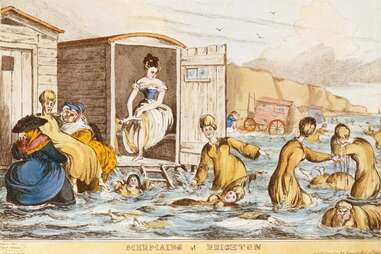TikTok Is Reclaiming the 'Hysteric' Woman Sent Out to Sea
A look back at the "sea cure" trope, and why “Edna Pontellier core” is making the rounds right now.

Plato once said, “The sea cures all ailments of man.” It’s an ancient thought we continue to honor, with kitschy wooden signs that say things like, A walk on the beach is good for the soul. But the Greek philosopher could not have foreseen how such a declarative statement would eventually skew feminine.
Trace the earliest records of the 19th-century beach resort, or search the shelves of feminist literature, and you’ll find a cast of women seeking convalescence by the seaside. Today, we rightfully scoff at the idea of doctors prescribing “hysteric” women a “sea cure” as a dismissal of female mental health and all its complexities. But social media is wondering: Barring the sexism that clouded such diagnoses, were these doctors onto something?
TikTok has taken to reclaiming this thalassic remedy, sticking up the metaphorical middle finger to our modern healthcare system and the corporate powers that be. This embrace of natural rest and recuperation while channeling the divine feminine is a thing to behold. It’s all fruits in the sun and flowy white dresses coupled with a blithe disregard for the ticking clocks of the real world, accompanied by comments like: “Edna Pontellier core”; “This is giving 1930’s baddie”; “No because y’all don’t know the lengths I would go to get diagnosed with hysteria.”
The origin of the “mad” woman at sea
The concept of recuperating by the shore dates back to the 18th century, when the English began to look to the ocean as a healing entity. Prior to that, the deep blue was a source of major terror for Europeans. “Only after explorers like Magellan and Vespucci began returning from their long journeys at sea did we see the first signs of a changing perspective,” says Sarah Stodola, author of The Last Resort. “In 1719, Robinson Crusoe was published, turning the ocean and an island shipwreck into a triumphant adventure.”
The 18th century also saw the Romantic era, which changed Europeans' approach to nature. In the 1750s, Richard Russell, a doctor based in Brighton, published theories on the medical properties of seawater, and by the 1800s, fashionable Brits began warming up to the beach as a space for recreation. This was the moment of the seaside resort, which arose in England as a response to the urbanization brought on by the Industrial Revolution. Stodola says, “In the early days of the English seaside resort, doctors prescribed all kinds of ‘cures’ involving seawater—washing the eyes with it, mixing it with wine at dinner, drinking it first thing in the morning, and dipping into hot or frigid seawater.”
Over time, we began to associate these rituals with female patients. “I don't think most of these cures were prescribed specifically to women—they were used to treat everything from low spirits to leprosy—but women were considered constitutionally weaker and more susceptible to illness, and thus were likely prescribed them more often on the whole,” Stodola explains. “Women were also far more likely to be diagnosed with ‘nervous disorders’ that would result in a prescription of sea air or sea bathing.”

In order to maintain standards of propriety, the Victorians invented constrictive contraptions called bathing machines, a type of horse drawn carriage that made its way into shallow waters. “[They] would take a swimmer into the water, where after changing into her bathing costumes in the carriage, she exited on the side facing away from the shore for her salubrious swim, ensuring privacy and decorum,” Stodola says. “These swims could be intense, sometimes involving being dunked repeatedly into the frigid ocean.”
There is, of course, truth to the notion that the ocean possesses curative powers—salt water heals wounds, after all. In 1843, a Polish doctor named Feliks Boczowski discovered that patients who labored in salt mines had fewer respiratory problems compared to those who worked elsewhere. And it’s a finding that continues to be accepted in medical circles. A recent study from the Massachusetts General Hospital revealed that breathing humid, salty air could promote upper airway cleansing and play a role in reducing COVID-19. And then there’s the sea water itself, which is rich in minerals and said to have anti-inflammatory effects on the skin.
But it’s literature that’s taught us that briny retreats offer women a kind of psychological release, too. In Kate Chopin’s The Awakening, Edna Pontellier views the ocean as an expanse from which to break away from the conventional roles of wife and mother. The imaginative Rhoda, in Virginia Woolf’s The Waves, stares into a basin of water and imagines it’s her own private ocean. In Little Women, Jo takes a sickly Beth to the beach in the hopes that it will lift her spirits. The island of Ischia plays a major role in Elena Ferrante’s Neapolitan Novels, where the protagonist experiences her first trip as an independent young woman and where Lila is later sent by a doctor to “work” on her fertility.
The same trope appears in film, often placing particular emphasis on two women healing with one another in the sand. Ingmar Bergman’s 1966 psychological horror, Persona, at least begins with that premise: A young nurse cares for an actress who has inexplicably gone mute in a remote island cottage. In the 2020 film Ammonite, a husband sends his “melancholic” wife, (played by Saoirse Ronan) to a beachside town, asking a fossil collector (Kate Winslet) to watch over her. Spoiler alert: They fall in love.
There’s no doubt that 18th century medicine was fraught with misogyny, and “hysteria” was a misdiagnosis, to say the least. But the restorative benefits of being in nature can’t be denied, and the pandemic has stoked our impulse to reconnect with it. Patricia Hasbach, licensed psychotherapist and author of Grounded, specializes in ecotherapy, a method of treatment that recognizes the healing benefits of interactions with nature.
“So much of our contemporary life is tempered by living in very domestic environments now, where we’re sitting in our air-conditioned and heated homes, breathing purified air, and drinking treated water,” Hasbach says. “We lose that sense of wildness that we, as an evolutionary species, grew up with.”
Hasbach has picked up on a renewed interest in green and blue spaces, attributing the latter to Dr. Wallace J Nichols, a marine biologist and author of Blue Mind, an analysis of human connection to water. But there’s a commonality across the board, she says, in nature making us feel alive again.
“We now have neuroscientists being able to hook us up and actually measure what happens to the brain when we are in more natural settings,” Hasbach says. “And what we find is that heart rate flows, blood pressure lowers, our cortisol—which is our stress hormone that kicks in when we're highly stressed—is lowered.” In other words, we relax.
The beach, in particular, is chock full of physical elements that take us to a place of zen. “They’re called ecotones, these areas between two different elements of the natural world—the water and the land,” Hasbach says. Humans also give in to the satisfying sight of naturally repeating fractal patterns at the beach, whether those are ripples in the sand created by tidal currents, or spiral designs on shells. They mirror the never-ending patterns of our own bodies, like the veins that peek through our skin.
Everything is cyclical—even Victorian trends
It seems as though we’ve come full circle with modern wellness, for better or worse. Many of the trends present today—from sea moss smoothies and cold plunge recovery to the very act of walking—can be thought of as a recycling of Victorian ideas, and the TikTok girlies can’t seem to get enough of them. The detox clinics and longevity centers touted by influencers certainly carry traces of the past, too. “A lot of wellness trends today are based on unsound medical or scientific beliefs, and the same was true of the cures prescribed at early seaside resorts,” Stodola says. “The environment at today's high-end wellness retreats is actually very similar, with their mix of luxury and health concerns.”
We can all at least agree that there’s no harm in escaping to the beach, especially when burnout is at an all time high. Everyday, we’re confronted with a new kind of “fatigue.” If trends like “bleisure” travel and “pay-cations” allow work to co-opt our vacations and “bed rotting” is the new form of self care, why not glamorize Edna Pontellier’s spiritual awakening on the Grand Isle—minus her devastating fate? It’s just a shame our jaunts to the sea, sun, and sand aren’t covered by insurance.